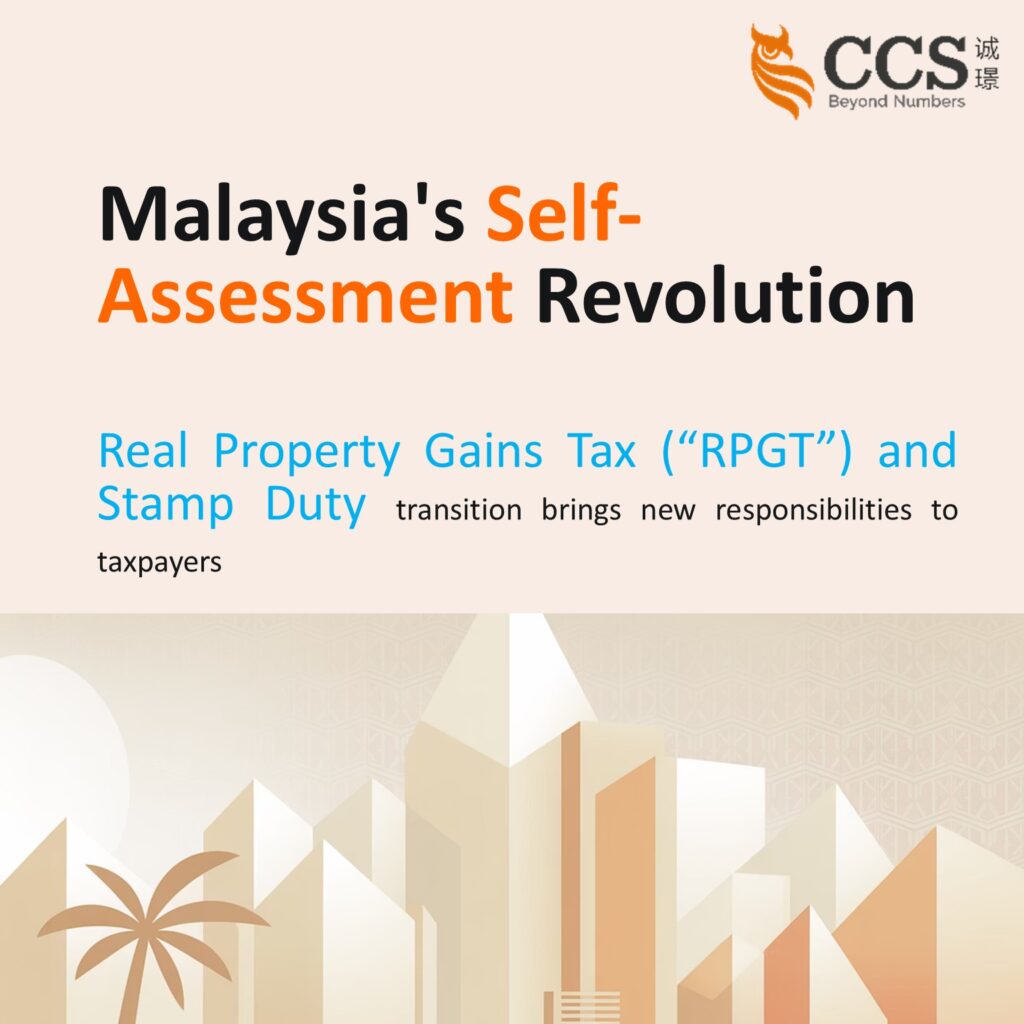
The Government of Malaysia has expanded the application of the Self-Assessment System (SAS) to include Real Property Gains Tax (RPGT) and Stamp Duty, shifting the responsibility of computing tax liabilities from the Inland Revenue Board (IRB) to taxpayers and duty payers.
This transition requires taxpayers and duty payers to declare the appropriate amounts in accordance with the Real Property Gains Tax Act 1976 and the Stamp Act 1949, respectively.
The IRB will now focus on conducting audits to ensure compliance.
![]() Real Property Gains Tax (RPGT)
Real Property Gains Tax (RPGT)
Introduction of SAS for RPGT
The SAS for RPGT was implemented starting January 1, 2025, following the gazette of the Finance Act 2024 and the Measures for the Collection, Administration and Enforcement of Tax Bill 2024 on December 31, 2024.
Key details include:
![]() Filing RPGT returns: Within sixty (60) days from the date of disposal.
Filing RPGT returns: Within sixty (60) days from the date of disposal.
![]() Paying RPGT: Within ninety (90) days from the date of disposal.
Paying RPGT: Within ninety (90) days from the date of disposal.
![]() Date of disposal: Based on the date of agreement, or, if there is no agreement, the date of completion of the disposal.
Date of disposal: Based on the date of agreement, or, if there is no agreement, the date of completion of the disposal.
![]() Disposal price: The amount or value of the consideration in money or money’s worth for the disposal of the chargeable asset.
Disposal price: The amount or value of the consideration in money or money’s worth for the disposal of the chargeable asset.
![]() RPGT rates: Range from 0% to 30%, depending on the type of taxpayer and the holding period.
RPGT rates: Range from 0% to 30%, depending on the type of taxpayer and the holding period.
![]() RPGT Audit Framework
RPGT Audit Framework
The RPGT Audit Framework was published on January 1, 2025, to encourage voluntary compliance, provide awareness, and penalise errant taxpayers.
![]() Audit period: Covers the preceding three (3) years of assessment (YAs).
Audit period: Covers the preceding three (3) years of assessment (YAs).
If issues are discovered, it may extend up to five (5) preceding YAs, with no time limit for cases of fraud or willful default.
![]() Audit selection criteria: Based on risk assessment, information from third parties, specific issues for certain disposers, location-based selection, or other methods the IRB deems fit.
Audit selection criteria: Based on risk assessment, information from third parties, specific issues for certain disposers, location-based selection, or other methods the IRB deems fit.
![]() Audit process and timeframe:
Audit process and timeframe:
![]() Initial Action: IRB issues an information request letter (via email or post) requiring documents within fourteen (14) days.
Initial Action: IRB issues an information request letter (via email or post) requiring documents within fourteen (14) days.
If no documents are needed, a Notice of Assessment with tax adjustments is issued directly.
![]() Document Review: RPGT Audit Officers review all documents related to asset disposal, including expenses and incidental costs, and may review other documents if necessary.
Document Review: RPGT Audit Officers review all documents related to asset disposal, including expenses and incidental costs, and may review other documents if necessary.
Officers have full access to records and can make copies; original document seizures require a list and acknowledgment.
![]() Conclusion of Audit: Taxpayers may be summoned to discuss findings.
Conclusion of Audit: Taxpayers may be summoned to discuss findings.
An audit findings letter is issued with reasons for issues raised.
Taxpayers have eighteen (18) days to appeal with supporting documents. Failure to appeal implies agreement.
Finally, an audit resolution letter, along with a Notice of Assessment, Notice of Additional Assessment, or Certificate of Non-Chargeability, is issued.
If no adjustments are made, a letter of conclusion with no findings is issued.
![]() Audit Timeline: Must be completed within ninety (90) days from the start of the audit or the date of the information request letter.
Audit Timeline: Must be completed within ninety (90) days from the start of the audit or the date of the information request letter.
![]() Generally requested documents: Include stamped Sale and Purchase Agreements (SPAs), Form 14A, Memorandum of Transfer (MOT), valuation reports, supporting documents for discounts/rebates, expenditure documents, Certificate of Non-Chargeability (CKHT 5 or 5A), Power of Attorney, and probate/administration letters for estate disposals.
Generally requested documents: Include stamped Sale and Purchase Agreements (SPAs), Form 14A, Memorandum of Transfer (MOT), valuation reports, supporting documents for discounts/rebates, expenditure documents, Certificate of Non-Chargeability (CKHT 5 or 5A), Power of Attorney, and probate/administration letters for estate disposals.
Additional documents like identity cards, audited financial statements, and bank statements may be requested.
![]() Voluntary disclosure: Allowed in writing (letter or electronic medium) anytime after the due date for RPGT returns, provided the IRB has not initiated an audit.
Voluntary disclosure: Allowed in writing (letter or electronic medium) anytime after the due date for RPGT returns, provided the IRB has not initiated an audit.
This is only available to taxpayers who have already submitted RPGT returns.
![]() Penalties (Section 30(2) of RPGTA): 45% for audited cases; 10% for voluntary disclosure within six months from the due date; 20% for voluntary disclosure after six months.
Penalties (Section 30(2) of RPGTA): 45% for audited cases; 10% for voluntary disclosure within six months from the due date; 20% for voluntary disclosure after six months.
![]() Appeal process: Taxpayers dissatisfied with an assessment can appeal to the Special Commissioners of Income Tax by submitting Form Q within thirty (30) days of receipt of the notice.
Appeal process: Taxpayers dissatisfied with an assessment can appeal to the Special Commissioners of Income Tax by submitting Form Q within thirty (30) days of receipt of the notice.
![]() Stamp Duty
Stamp Duty
Introduction of SAS for Stamp Duty
The SAS for stamp duty will be implemented in phases, starting from January 1, 2026, following the gazette of the Finance Act 2024 and Measures for the Collection, Administration and Enforcement of Tax Bill 2024.
The legal framework for this implementation is primarily set out in Part IV of the Tax Measures Bill.
![]() Phase 1 (From January 1, 2026): Covers instruments or agreements related to rental or lease, general agreement stamping, and securities.
Phase 1 (From January 1, 2026): Covers instruments or agreements related to rental or lease, general agreement stamping, and securities.
![]() Phase 2 (From January 1, 2027): Covers instruments of transfer of property ownership.
Phase 2 (From January 1, 2027): Covers instruments of transfer of property ownership.
![]() Phase 3 (From January 1, 2028): Covers all other instruments or agreements not included in Phase 1 and 2.
Phase 3 (From January 1, 2028): Covers all other instruments or agreements not included in Phase 1 and 2.
Key details of SAS for stamp duty include:
![]() Filing stamp duty returns: Electronically, with the executed instrument, specifying its description, chargeable duty, and other particulars required by LHDN.
Filing stamp duty returns: Electronically, with the executed instrument, specifying its description, chargeable duty, and other particulars required by LHDN.
![]() If executed in Malaysia: Within thirty (30) days from the date of execution.
If executed in Malaysia: Within thirty (30) days from the date of execution.
![]() If executed outside Malaysia: Within thirty (30) days after it has been first received in Malaysia. “Received in Malaysia” includes electronic transmission, with the date verified by a copy or print-out of the transmission.
If executed outside Malaysia: Within thirty (30) days after it has been first received in Malaysia. “Received in Malaysia” includes electronic transmission, with the date verified by a copy or print-out of the transmission.
![]() Paying stamp duty:
Paying stamp duty:
![]() If executed in Malaysia: Within thirty (30) days from the date of execution.
If executed in Malaysia: Within thirty (30) days from the date of execution.
![]() If executed outside Malaysia: Within thirty (30) days from the date it is first brought into Malaysia.
If executed outside Malaysia: Within thirty (30) days from the date it is first brought into Malaysia.
![]() Liability for stamp duty: Depends on the instrument type as specified in the Third Schedule of the Stamp Act 1949.
Liability for stamp duty: Depends on the instrument type as specified in the Third Schedule of the Stamp Act 1949.
Otherwise, it is generally the person who prepares or signs the document.
![]() Types of stamp duty: Fixed Duty (chargeable regardless of consideration) and Ad Valorem Duty (chargeable based on consideration or market value).
Types of stamp duty: Fixed Duty (chargeable regardless of consideration) and Ad Valorem Duty (chargeable based on consideration or market value).
Upon electronic submission of a return, the Collector is deemed to have made an assessment based on the provided information, and the duty becomes due and payable on the day of assessment.
However, the Collector retains the discretion to conduct an independent assessment (Adjudication Route) and charge the correct amount if insufficient duty was declared.
The Collector can request an abstract, affidavit, or other evidence for this purpose.
![]() Stamp Duty Audit Framework
Stamp Duty Audit Framework
The Stamp Duty Audit Framework was published on January 1, 2025.
Types of stamp duty audit:
![]() General review: A review of instruments and documents submitted during stamping application, with interviews if needed.
General review: A review of instruments and documents submitted during stamping application, with interviews if needed.
![]() Comprehensive review: A review of all instruments and agreements executed by the duty payer, potentially at their premises.
Comprehensive review: A review of all instruments and agreements executed by the duty payer, potentially at their premises.
![]() Audit period: Covers the preceding three (3) calendar years, with no time limit for cases of fraud, duty evasion, or willful default.
Audit period: Covers the preceding three (3) calendar years, with no time limit for cases of fraud, duty evasion, or willful default.
![]() Audit selection criteria: Based on risk assessment, specific industries, specific issues for certain duty payers, and information from third parties.
Audit selection criteria: Based on risk assessment, specific industries, specific issues for certain duty payers, and information from third parties.
![]() Audit process and timeframe:
Audit process and timeframe:
![]() Initial Action: An Audit Notification Letter (general review) or Audit Visit Letter (comprehensive review) is issued. Duty payers must furnish requested documents within fourteen (14) days.
Initial Action: An Audit Notification Letter (general review) or Audit Visit Letter (comprehensive review) is issued. Duty payers must furnish requested documents within fourteen (14) days.
![]() Document Review: Audit Officers have full access to stamping records and other relevant documents, with powers to make copies.
Document Review: Audit Officers have full access to stamping records and other relevant documents, with powers to make copies.
Seizing original documents requires a list and acknowledgment.
![]() Conclusion of Audit: Duty payers may be summoned to discuss findings.
Conclusion of Audit: Duty payers may be summoned to discuss findings.
An audit findings letter is issued, allowing fourteen (14) days for appeal. Failure to appeal implies agreement.
An audit resolution letter, along with a Notice of Confirmation of Assessment or Notice of Amended Assessment, is then issued.
![]() Audit Timeline: Seven (7) days for general review; sixty (60) days for comprehensive review.
Audit Timeline: Seven (7) days for general review; sixty (60) days for comprehensive review.
![]() Voluntary disclosure: Allowed in writing anytime after three (3) months from the due date for stamping, provided an audit has not been initiated.
Voluntary disclosure: Allowed in writing anytime after three (3) months from the due date for stamping, provided an audit has not been initiated.
This is only for duty payers who have already submitted the instrument via the STAMPS portal.
![]() Penalties for late stamping (Section 47A):
Penalties for late stamping (Section 47A):
* Effective from January 1, 2025:
a) Within 3 months after the deadline: RM50 or 10% of the deficient duty, whichever is greater.
b) After 3 months from the deadline: RM100 or 20% of the deficient duty, whichever is greater.
* The Collector may reduce or remit such penalties [195, 47A(2), 519].
![]() Appeal process: Dissatisfied duty payers can object to the Collector of Stamp Duty within thirty (30) days for a review.
Appeal process: Dissatisfied duty payers can object to the Collector of Stamp Duty within thirty (30) days for a review.
If still dissatisfied, an appeal can be made to the High Court within twenty-one (21) days of the Collector’s written decision.
![]() Key Concepts and General Amendments for Stamp Duty
Key Concepts and General Amendments for Stamp Duty
![]() Definition of “Instrument” and “Writing”: The Stamp Act 1949 defines “instrument” to include every written document, and “writing” or “written” to include any handwriting, typewriting, printing, electronic record or transmission which is in an electronically readable form.
Definition of “Instrument” and “Writing”: The Stamp Act 1949 defines “instrument” to include every written document, and “writing” or “written” to include any handwriting, typewriting, printing, electronic record or transmission which is in an electronically readable form.
This amendment gives legal recognition to electronic instruments for stamp duty liability.
![]() Compulsory Stamping: With the introduction of the self-assessment regime from January 1, 2026, it becomes compulsory for instruments to be stamped.
Compulsory Stamping: With the introduction of the self-assessment regime from January 1, 2026, it becomes compulsory for instruments to be stamped.
Previously, the law did not explicitly compel stamping for all instruments, but certain transactions required stamped documents for legal effect or use in court.
![]() Record Keeping: From January 1, 2026, every person liable to pay duty must keep the instrument and all relevant documents for seven years from the date the duty is paid, to ascertain that the proper amount of duty was paid.
Record Keeping: From January 1, 2026, every person liable to pay duty must keep the instrument and all relevant documents for seven years from the date the duty is paid, to ascertain that the proper amount of duty was paid.
Failure to do so without reasonable excuse is an offense punishable by a fine up to RM10,000.
![]() Collector’s Powers: The Collector’s powers have been expanded to include requiring document production, inspecting all lands, buildings, and places, accessing books and documents (physical or electronic), taking possession of documents (if inspection is difficult, documents may be interfered with, or needed as evidence), and authorizing valuers.
Collector’s Powers: The Collector’s powers have been expanded to include requiring document production, inspecting all lands, buildings, and places, accessing books and documents (physical or electronic), taking possession of documents (if inspection is difficult, documents may be interfered with, or needed as evidence), and authorizing valuers.
The Collector can also request translations of documents not in Malay (or English for East Malaysia) within a minimum of 30 days.
Obstruction or non-compliance can lead to a fine up to RM10,000.
![]() Powers to Raise Assessments: The Collector has authority to raise assessments or additional assessments within five years from the date duty was paid if the original assessment was insufficient.
Powers to Raise Assessments: The Collector has authority to raise assessments or additional assessments within five years from the date duty was paid if the original assessment was insufficient.
Assessments can be raised without time limitation if duty was lost due to fraud, willful default, or negligence.
![]() Minimum Duty: A minimum stamp duty of RM10 will apply to all instruments, except for cheques and contract notes.
Minimum Duty: A minimum stamp duty of RM10 will apply to all instruments, except for cheques and contract notes.
![]() Penalties for Fraud/Incorrect Returns: The fine for defrauding the government of any duty is increased from a fixed RM5,000 to between RM1,000 and RM20,000.
Penalties for Fraud/Incorrect Returns: The fine for defrauding the government of any duty is increased from a fixed RM5,000 to between RM1,000 and RM20,000.
Making an incorrect return or providing incorrect information can lead to a fine between RM1,000 and RM10,000, plus a special penalty equivalent to the underpaid duty.
Failure to furnish a return without reasonable excuse can result in a fine up to RM10,000, or a penalty between RM200 and RM2,000 if no prosecution is brought.
![]()
![]() Latest Developments on Stamping of Employment Contracts
Latest Developments on Stamping of Employment Contracts
The IRB (LHDN) has intensified enforcement of the Stamp Act 1949 regarding employment contracts since January 2025, conducting comprehensive audits.
Employment contracts fall under Item 4 of the First Schedule of the Stamp Act 1949 as “agreement or memorandum of agreement made under hand only” and are subject to a fixed stamp duty of RM10 per contract.
Exemptions: Only contracts for employees earning below RM300 per month are exempt from stamp duty. The Malaysian Employers Federation (MEF) has proposed raising this outdated exemption limit.
![]() Timeline and Penalties:
Timeline and Penalties:
![]() Before January 1, 2025: Employment contracts executed before this date are exempted from stamp duty obligations, and applicable penalties will be remitted.
Before January 1, 2025: Employment contracts executed before this date are exempted from stamp duty obligations, and applicable penalties will be remitted.
![]() January 1, 2025, to December 31, 2025: Contracts finalized within this period are subject to stamp duty.
January 1, 2025, to December 31, 2025: Contracts finalized within this period are subject to stamp duty.
However, a remission of late stamping penalties will be granted if they are stamped on or before December 31, 2025.
Employers must submit an appeal for penalty waiver after receiving audit results and before making payment via the STAMPS portal.
![]() On or after January 1, 2026: Employment contracts finalized from this date onwards will be subject to stamp duty, and any delays in stamping will result in penalties being imposed.
On or after January 1, 2026: Employment contracts finalized from this date onwards will be subject to stamp duty, and any delays in stamping will result in penalties being imposed.
Responsibility: The employer is responsible for stamping and bearing the cost, as they are considered the party who first executes the contract.
Stamping Process: Contracts must be stamped within 30 days of signing.
Stamping can be done online through the LHDNM STAMPS portal (stamps.hasil.gov.my).
Only one stamped copy is generally required for the employer.
Validity and Enforceability: An unstamped employment contract remains legally valid and binding between parties.
However, it cannot be admitted as evidence in court unless duly stamped. The Industrial Court, being a court of equity, has for now accepted unstamped employment agreements.
The shift to SAS for RPGT and Stamp Duty signifies a higher level of responsibility for taxpayers and consultants, requiring continuous updates on laws and regulations.
The IRB’s audits serve to educate and ensure compliance in this evolving tax landscape.
马来西亚政府已将自我评估系统(SAS)的适用范围扩展至不动产利得税(RPGT)和印花税,将计算税负的责任从马来西亚内陆税收局(IRB)转移至纳税人和税款缴纳人。
此项转变要求纳税人及税款缴纳人分别依据《1976年不动产利得税法令》和《1949年印花税法》申报相应税额。
内陆税务局现将重点转向开展审计以确保合规。
![]() 不动产利得税(RPGT)
不动产利得税(RPGT)
RPGT在线申报系统启用
随着《2024年财政法案》及《2024年税收征收、管理与执行措施法案》于2024年12月31日公告生效,RPGT在线申报系统自2025年1月1日起正式实施。
核心条款包括:
![]() RPGT申报:须于资产处置后六十(60)日内完成
RPGT申报:须于资产处置后六十(60)日内完成
![]() 缴纳RPGT:处置之日起九十(90)日内。
缴纳RPGT:处置之日起九十(90)日内。
![]() 处置日期:以协议日期为准;若无协议,则以处置完成日为准。
处置日期:以协议日期为准;若无协议,则以处置完成日为准。
![]() 处置价格:处置应税资产所获货币或货币价值对价的金额或价值。
处置价格:处置应税资产所获货币或货币价值对价的金额或价值。
![]() 资本利得税率:根据纳税人类别及持有期限,税率范围为0%至30%。
资本利得税率:根据纳税人类别及持有期限,税率范围为0%至30%。
![]() 资本利得税审计框架
资本利得税审计框架
该框架于2025年1月1日发布,旨在鼓励自愿合规、提升纳税意识并惩处违规行为。
![]() 审计周期:涵盖前三个(3)课税年度(YAs)。
审计周期:涵盖前三个(3)课税年度(YAs)。
若发现问题,可追溯至前五(5)个课税年度,欺诈或故意违约案件则无追溯期限。
![]() 审计选定标准:基于风险评估、第三方信息、特定处置人问题、地域选定或其他税务局认为合适的方法。
审计选定标准:基于风险评估、第三方信息、特定处置人问题、地域选定或其他税务局认为合适的方法。
![]() 审计流程与时间框架:
审计流程与时间框架:
![]() 初始行动:税务局通过电子邮件或邮寄发出信息请求函,要求在十四(14)日内提交文件。
初始行动:税务局通过电子邮件或邮寄发出信息请求函,要求在十四(14)日内提交文件。
若无需文件,则直接发出含税款调整的评估通知书。
![]() 文件审查:资本利得税审计专员将审查所有资产处置相关文件(含费用及附带成本),必要时可审查其他文件。
文件审查:资本利得税审计专员将审查所有资产处置相关文件(含费用及附带成本),必要时可审查其他文件。
官员可全权查阅记录并复制文件;扣押原始文件需提供清单及确认书。
![]() 审计结论:纳税人可能被传唤讨论审计结果。
审计结论:纳税人可能被传唤讨论审计结果。
审计结果函将载明问题缘由。
纳税人须在十八(18)日内提交佐证材料提出申诉。未申诉视为同意。
最终将签发审计决议函,同时附上评估通知书、追加评估通知书或免税证明书。
若无调整事项,则签发无发现函。
![]() 审计时限:须在审计启动或信息要求函发出之日起九十(90)日内完成。
审计时限:须在审计启动或信息要求函发出之日起九十(90)日内完成。
![]() 常规要求文件:含盖章买卖协议(SPAs)、表格14A、转让备忘录(MOT)、估值报告、折扣/回扣证明文件、支出凭证、不动产利得税证明书(CKHT 5或5A)、授权书及遗产处置的遗嘱认证/遗产管理函。
常规要求文件:含盖章买卖协议(SPAs)、表格14A、转让备忘录(MOT)、估值报告、折扣/回扣证明文件、支出凭证、不动产利得税证明书(CKHT 5或5A)、授权书及遗产处置的遗嘱认证/遗产管理函。
可能额外要求提供身份证件、经审计的财务报表及银行对账单等文件。
![]() 自愿披露:在房地产收益税申报截止日后任何时间均可书面(信函或电子媒介)提交,前提是税务局尚未启动审计程序。
自愿披露:在房地产收益税申报截止日后任何时间均可书面(信函或电子媒介)提交,前提是税务局尚未启动审计程序。
此项仅适用于已提交房地产收益税申报的纳税人。
![]() 罚则(RPGTA第30(2)条):经审计案件按45%计罚;申报截止日起六个月内自愿披露按10%计罚;逾期六个月后自愿披露按20%计罚。
罚则(RPGTA第30(2)条):经审计案件按45%计罚;申报截止日起六个月内自愿披露按10%计罚;逾期六个月后自愿披露按20%计罚。
![]() 上诉程序:纳税人若对评估结果不满,可在收到通知书后三十(30)日内提交Q表向所得税特别专员提出上诉。
上诉程序:纳税人若对评估结果不满,可在收到通知书后三十(30)日内提交Q表向所得税特别专员提出上诉。
![]() 印花税
印花税
印花税电子化服务(SAS)实施说明
印花税电子化服务将分阶段实施,自2026年1月1日起生效,具体以《2024年财政法案》及《2024年税收征收管理与执行法案》公告为准。
该实施的法律框架主要载于《税收管理法案》第四部分。
![]() 第一阶段(2026年1月1日起):涵盖租赁协议、常规协议印花及证券类文书。
第一阶段(2026年1月1日起):涵盖租赁协议、常规协议印花及证券类文书。
![]() 第二阶段(2027年1月1日起):涵盖财产所有权转让文书。
第二阶段(2027年1月1日起):涵盖财产所有权转让文书。
![]() 第三阶段(2028年1月1日起):涵盖第一、二阶段未包含的所有其他文书或协议。
第三阶段(2028年1月1日起):涵盖第一、二阶段未包含的所有其他文书或协议。
印花税电子申报系统(SAS)关键细节包括:
![]() 提交印花税申报:须通过电子方式提交已签署文书,并注明文书描述、应缴税额及内陆税收局(LHDN)要求的其他细节。
提交印花税申报:须通过电子方式提交已签署文书,并注明文书描述、应缴税额及内陆税收局(LHDN)要求的其他细节。
![]() 马来西亚境内签署:自签署日起三十(30)日内。
马来西亚境内签署:自签署日起三十(30)日内。
![]() 马来西亚境外签署:文件首次抵达马来西亚后三十(30)日内。“抵达马来西亚”包括电子传输,以传输副本或打印件验证日期。
马来西亚境外签署:文件首次抵达马来西亚后三十(30)日内。“抵达马来西亚”包括电子传输,以传输副本或打印件验证日期。
![]() 印花税缴纳时限:
印花税缴纳时限:
![]() 马来西亚境内签署:自签署之日起三十(30)日内。
马来西亚境内签署:自签署之日起三十(30)日内。
![]() 马来西亚境外签署:自文件首次带入马来西亚之日起三十(30)日内。
马来西亚境外签署:自文件首次带入马来西亚之日起三十(30)日内。
![]() 印花税责任主体:依据《1949年印花税法令》附表三规定的文书类型确定。
印花税责任主体:依据《1949年印花税法令》附表三规定的文书类型确定。
若无特别规定,通常由文件起草人或签署人承担。
![]() 印花税类型:固定税额(无论交易金额均需缴纳)与从价税(按交易金额或市场价值计征)。
印花税类型:固定税额(无论交易金额均需缴纳)与从价税(按交易金额或市场价值计征)。
电子申报后,税务专员将依据所提供信息进行评估,印花税于评估当日即产生应缴义务。
但若申报税额不足,税务专员保留独立评估(裁定途径)并追缴正确税额的裁量权。
为此目的,税务专员可要求提供摘要、宣誓书或其他证据。
![]() 印花税审计框架
印花税审计框架
印花税审计框架于2025年1月1日发布。
印花税审计类型:
![]() 常规审查:核查印花申请时提交的文书及文件,必要时进行访谈。
常规审查:核查印花申请时提交的文书及文件,必要时进行访谈。
![]() 全面审查:核查纳税人签署的所有文书及协议,可能在纳税人场所进行。
全面审查:核查纳税人签署的所有文书及协议,可能在纳税人场所进行。
![]() 审计周期:涵盖前三个(3)日历年度,涉及欺诈、逃税或故意违约案件则无时间限制。
审计周期:涵盖前三个(3)日历年度,涉及欺诈、逃税或故意违约案件则无时间限制。
![]() 审计选取标准:基于风险评估、特定行业、特定纳税人问题及第三方信息。
审计选取标准:基于风险评估、特定行业、特定纳税人问题及第三方信息。
![]() 审计流程与时限:
审计流程与时限:
![]() 初始行动:发出审计通知函(常规审查)或审计访问函(全面审查)。纳税人须在十四(14)日内提交所需文件。
初始行动:发出审计通知函(常规审查)或审计访问函(全面审查)。纳税人须在十四(14)日内提交所需文件。
![]() 文件审查:审计官员有权查阅所有印花记录及其他相关文件,并可复制文件。
文件审查:审计官员有权查阅所有印花记录及其他相关文件,并可复制文件。
扣押原始文件需出具清单并签署确认。
![]() 审计结案:纳税人可能被传唤讨论审查结果。
审计结案:纳税人可能被传唤讨论审查结果。
随后发出审计结果函,赋予十四(14)天申诉期。未申诉视为同意。
继而发出审计决议函,并附评估确认通知书或修正评估通知书。
![]() 审计时限:常规审查7天;全面审查60天。
审计时限:常规审查7天;全面审查60天。
![]() 自愿披露:在印花税缴纳截止日起三个月后,且审计尚未启动时,可随时以书面形式申请。
自愿披露:在印花税缴纳截止日起三个月后,且审计尚未启动时,可随时以书面形式申请。
此条款仅适用于已通过STAMPS门户提交文书的纳税人。






